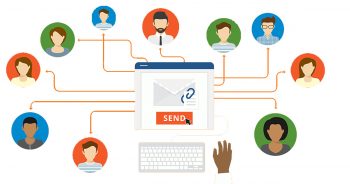Email lists and newsletters have been around for years and if you run a blog or a business with and online presence, our number one tip for you is to focus on growing your email list. However if you don’t ever intend to sell products or services of any kind, then you probably don’t need an email list, but you may want to keep on reading anyway.
When you use email as a way to communicate to your audience, there are less competing messages and email subscribers are more likely to be your product or service buyers. Believe it or not, you will see a lot less emails in your inbox than an average day of scrolling through status updates, images and tweets. Additionally, people are a lot less picky with who they follow on social media, compared to when someone gives you their email address, they have given you permission to talk directly to them. The permission based marketing approach is key to why email marketing is the highest return on investment you can get for your advertising dollar, because if a visitor manually opt’s in to join your email list, then they usually do want to hear from you.
1. Email lists are all about control
Aside from your website, it’s the only thing you have control over. You don’t own your search engine rankings, or your social media sites. They can be taken away from you at a moment’s notice, completely in accord with the terms of service you signed when you created your account.
If you use social media and don’t get us wrong, we think it is absolutely imperative to growing a profitable business online, you can get more business if you also have an email list. The biggest problem with social media is that you have zero control, Facebook, Instagram or Pintrest could shut down your account, or more likely revise their policies and make it harder to reach your own audience that you spent hours, days, weeks or even years growing. Now only an average of 2–4% of your Facebook audience sees any given post you create and you have no control over who will see that post and nor do your customers and clients. Outside of your email being bounced for some reason, almost 100% of your emails will make it to an inbox.
Think of it this way: a person’s email inbox is considered sacred and something they should have control over. If they allow you to send them emails, then they’re essentially inviting you into their virtual home. People hate getting useless spam in their inbox, but they’re willing to scroll through an Instagram feed full of photos from acquaintances they’ve talked to twice in their life. Email lists are about a person choosing to receive your updates, special offers, exclusive discounts or content, and it is your responsibility to control the content and frequency when you interact with your email list.
2. An email list is the cheapest way to communicate with your audience
Let’s use Mailchimp’s pricing as an example. For free, they’ll let you send 12,000 messages to a list of up to 2,000 subscribers. Say you send one email a week to your list, that’s up to 8,000 email messages a month, all sent to people that have shown interest in your product or service, for absolutely nothing. Additionally there is a cost of your time to create the email, but with practice and the great drag and drop editors available now, this should take you less than an hour a week. No other form of online advertising can compete with that reach and cost.
The statistics prove that email marketing is at least 5 times more effective in reaching your audience on social media.
- Typical emails have a 20% open rate and 2% click rate
- For 5,000 emails sent, approximately 1,000 people will that see your message and probably 100 will click to your site
- Typical social media reach 4% of your audience
- For 5,000 fans or followers, approximately 200 may see your post
In a climate where news travels fast and convenience is king, email marketing offers marketers the best way to connect with an audience quickly and cost-effectively. It’s reported that for every $1 spent, email marketing generates $38 in ROI, with email marketing topping the ranks for marketing over the past decade. Even if you hire a leading copywriter and get it designed by a professionals, it’ll still barely cost you $1,000, and that’s the Bentley version of an email.
3. Email marketing can be personal and is easily measurable
Because email messages can be personalised, they can be written almost as if it was you talking directly to the person you’re sending the email to… as if you had sat down to write them a personal note. Over the course of five or ten emails, your subscribers will come to know you and trust you. As you deliver highly-targeted, valuable content, your subscribers will trust you more and more and more.
If your emails aren’t relevant to your subscribers, they’ll end up in the trash or they will unsubscribe. Consumers expect brands to know who they are and provide them content they care about. You have to deliver the right message, to the right person, at the right time. If you are just starting out focus on delivering the message that they signed up to receive, and as your list grows, work towards segments and dynamic content that may vary to different users based on previous interactions.
Email marketing is a great way to measure feedback, at an individual level and essentially in real time. Every email that you send can be tracked, from delivery to open and even if an individual clicks, you can see what links they clicked on. With all of this data you collect, you can know exactly what works and what doesn’t – and you can recreate what worked over and over again.
4. Email sends can be scheduled and automated
Not everyone will check your Instagram or blog everyday unless they are absolutely crazy about your site. But what will they do? Well, they’ll probably check their email everyday. So, if you have something important to share, and want to be sure that your audience receives it, then an email list is an excellent medium to keep in touch. You can even schedule an email to send your latest blog post to your list every week.
As businesses grow, it becomes increasingly difficult to give one-to-one attention to each customer. With email automation, marketers can easily create workflows to send personalised, timely, relevant emails to customers at the right time. In the DIY revolution, modern email platforms enable marketers to do this on their own with just a couple clicks.
5. You could rebuild your entire business with just your email list.
Lastly, if you lost everything (your website, your blog, your social media accounts) you could still run your business with just an email list. You own your email list and No one can ever take it away from you. The importance of an email list cannot be understated regarding your success as selling products and services.
In summary
So why build an email list? Because you want something to show for all the work you do and your list is an asset that can be sold. Sending email updates is easy, fast and affordable. If you treat your subscribers right, every so often, if you really need cash fast, you can pitch them a product or offer and they may buy within hours. Don’t do this too often, but it’s nice to have access to that financial safety net.
Sending regular email updates is the best way to build trust. Trust is everything. Without it, even the most tempting offers will fizzles. Most importantly, make sure your audience doesn’t feel like all you want is their money. Be sure to bring value and usefulness to their lives! You can do this by offering advice, a new recipe or workout, or freebie just for fun.
Based on what we said in this article, you might get ahead of yourself, thinking that the faster you build a big list, the better. You may even turn to an online source that promises you thousands of email subscribers for a relatively small amount of money. Don’t do it. Buying email lists is a bad idea nearly 100 percent of the time. You rarely get what you pay for. Most of the subscribers will have old or fake email addresses, and the few who don’t probably aren’t interested in your services. Add in the possibility of getting flagged as a spammer, and you can see plainly why it’s almost always a bad investment.
If you need any help starting a list, growing your list or getting the most from your existing email list, contact the team at MyNext and let our team with years of experience in creating great emails lists help you.


